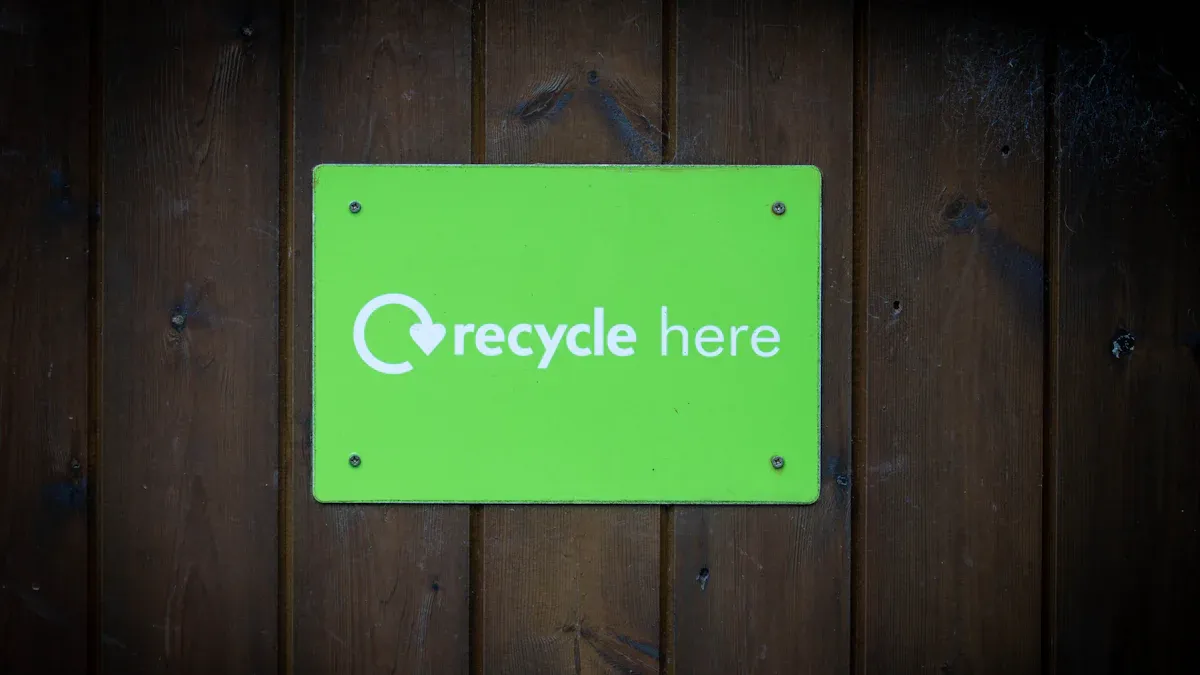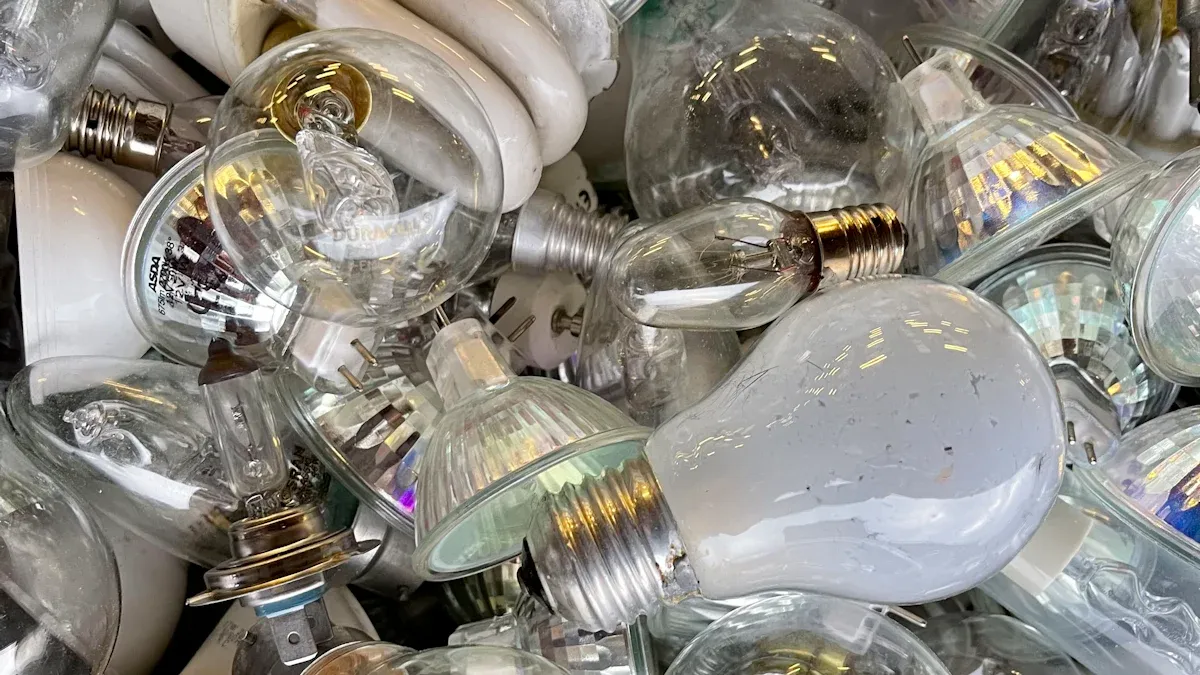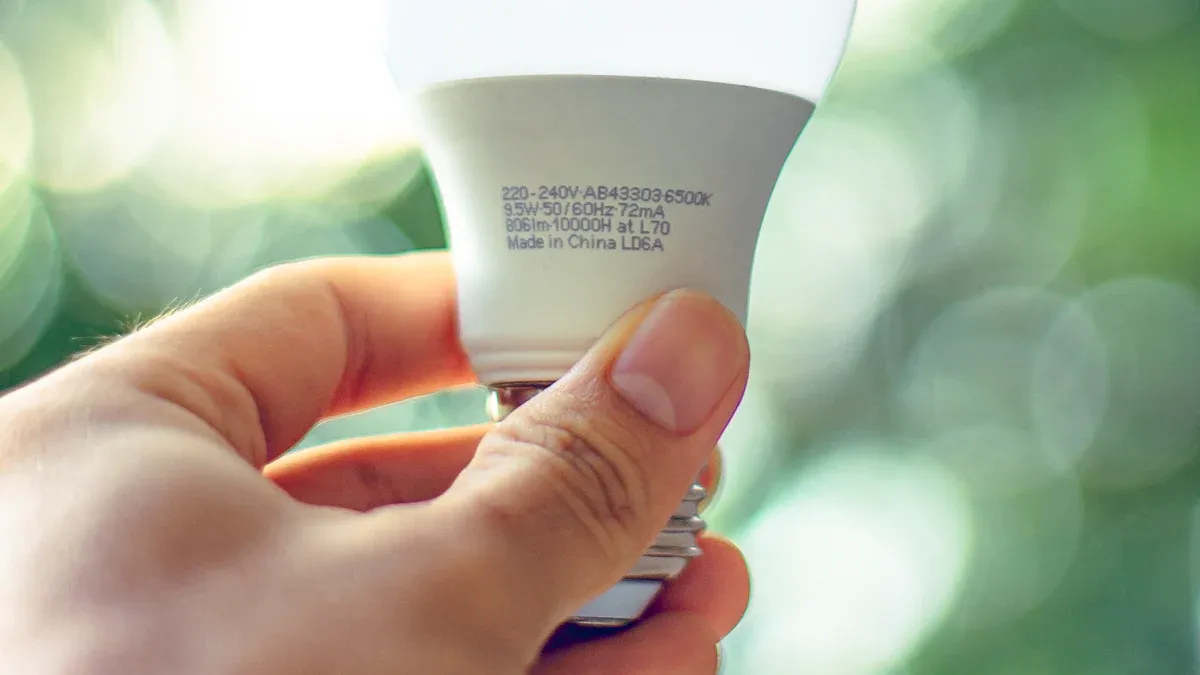LED Lamp Disposal: Differences Between Residential and Commercial Approaches

People often ask how led lamp disposal is different at home and at work. Most LED lamps do not have dangerous materials, so they are safer for nature. Many towns now want people to recycle Led Light products. Businesses have to follow strict rules, but people at home may have more choices. Picking the right way helps the environment and follows the rules. For more details, go to the Home page, look at the Product section, or read the About Us area.
Key Takeaways
Recycling LED lamps helps the earth. It keeps bad metals out of landfills. It also saves important materials like gold and copper. - People at home have more ways to throw away LED lamps. They should check local rules first. They can use drop-off spots or mail-back programs to recycle. - Businesses must follow strict laws. They need to use certified recyclers. Workers must get training to handle many LED lamps safely and by the law. - Collecting and handling LED lamps the right way stops pollution. It cuts down on waste. It also helps reuse materials in a circular economy. - Homes and businesses both gain from learning local rules. They should use recycling programs. This keeps LED lamp disposal safe and good for the earth.
LED Lamp Disposal Overview

LED Lamps and E-Waste
Getting rid of LED lamps is important for e-waste problems. People use LED lamps because they save energy. These lamps have different parts that add to e-waste. The parts are the carcass, LEDs, printed circuit boards (PCBs), and LED modules. Each part has valuable things like gold, silver, copper, gallium, indium, and rare earth metals. Most of these are found in the LEDs and PCBs. But there are also harmful things like lead and brominated flame retardants. These can make LED lamps count as hazardous waste.
Main components in LED lamps:
Carcass
LEDs
Printed circuit boards (PCBs)
LED modules
It is hard to manage LED lamp disposal. The many materials and toxic stuff make recycling tough. Not many LED lamps are collected the right way. A lot of lamps go to informal recycling, where people burn them outside or put them in landfills. This wastes good materials and hurts nature. Better recycling and eco-design can help get back materials and protect the planet. The circular economy idea means using things again and making less waste.
Environmental Impact
Throwing away LED lamps the wrong way is bad for the earth. LED lamps do not have mercury, but they do have lead, arsenic, and nickel. If people put LED lamps in landfills, these bad things can get into the ground and water. This can hurt nature and people's health. Breaking LED bulbs in landfills makes toxic dust, which pollutes the air.
Getting rid of e-waste the right way stops these dangers. Recycling LED lamps means we do not need to make as many new bulbs. This cuts down on carbon emissions and helps the planet.
Many towns now want people to recycle to handle e-waste better. Recycling LED lamps saves valuable materials and keeps nature safe. As more people throw away LED lamps, everyone needs to know why safe e-waste management matters.
Residential LED Lamp Disposal

Disposal Methods
When people at home need to get rid of led lamps, they have a few choices. Many just throw old bulbs in the trash. This is because most led lamps do not have mercury. In the United States, it is still legal to do this. Led lamps are not called hazardous waste. But experts say recycling is better. Recycling helps cut down on e-waste and saves useful materials.
Some stores and makers have drop-off spots for old led lamps. For example, IKEA lets people bring in led bulbs for recycling. Big lighting brands like Cree and Philips have recycling programs too. Local power companies sometimes take led bulbs in their recycling plans. These ways help keep things like lead and arsenic out of landfills.
Tip: Always ask your local waste or recycling center before throwing away led lamps. They might have special days or places for e-waste.
Residential E-Waste Recycling
Recycling e-waste at home is important. It helps deal with more and more old led lamps. Many towns have e-waste events or drop-off spots for electronics. These programs let people get rid of led lamps safely. They also make sure metals like copper, gold, and silver get reused.
Benefits of recycling e-waste at home:
Less trash goes to landfills
Gets back rare and useful metals
Stops toxic stuff from hurting soil and water
Helps reuse materials in the circular economy
Even with these good things, recycling e-waste at home has problems. Some places do not have the right recycling tools for led lamps. Old led bulbs can have heavy metals and need careful handling. Not everyone knows about recycling programs. So, many led lamps still end up in the trash.
Local Regulations
Rules for getting rid of led lamps at home are different in each place. In the United States, there is no national law against throwing led lamps in the trash. Most states do not have rules for led lamp disposal. This is because these bulbs have very little toxic stuff. But some states and cities want people to recycle. They work with stores to help people recycle more.
Europe has much stricter rules for recycling e-waste at home. The EU WEEE Directive says people must recycle led lamps. It treats them as hazardous waste when they are used up. This helps protect nature and people's health by making sure e-waste is handled right.
Ontario, Canada, has special rules too. Makers must take care of old lighting products, including led lamps from homes. These rules show that more places want to control e-waste better.
Note: Rules are changing as more people use led lights. People should learn about local rules and recycling choices to get rid of led lamps the right way.
Commercial LED Lamp Disposal
Commercial E-Waste Recycling
Businesses make a lot of e-waste when they change lights in big buildings. Commercial e-waste recycling programs help companies deal with this waste the right way. These programs collect, sort, and process led lamps and other lighting products. Many companies use certified recyclers who know how to handle commercial e-waste.
Commercial e-waste recycling has a few steps. First, workers gather used led lamps and put them in safe containers. Then, recyclers take apart the lamps into chips, heat sinks, circuit boards, and lenses. This helps get back metals and plastics. Led lamps come in many shapes and sizes, so recycling is harder. Some recycling systems do not fit led products, so companies might wait longer or pay more.
Commercial e-waste recycling keeps dangerous things out of landfills and helps reuse materials in the circular economy.
Regulations and Compliance
Strict rules tell businesses how to recycle commercial e-waste. In the United States, the Environmental Protection Agency (EPA) makes these rules with the Universal Waste Rule. This rule covers mercury lamps, but many states also add led lamps to their programs. Businesses must follow both federal and state laws, which can be different.
Key steps for businesses include:
Labeling containers as "Universal Waste Lamp(s)" or something like that.
Storing used led lamps in strong, closed containers to stop breakage.
Training workers on how to handle and what to do in emergencies.
Keeping records of storage times and recycling work.
Not using bulb crushers in states where they are not allowed.
Businesses cannot switch between universal waste and hazardous waste rules to keep waste longer. Some states have tougher rules than the federal government, so companies must check local laws. Certified recyclers can help set up programs that follow all the rules. Good recordkeeping and following the rules keep companies safe from fines and help manage e-waste safely.
Collection and Handling
Handling lots of led lamps is hard for businesses. Commercial e-waste recycling often means dealing with thousands of lamps at once. Workers must collect, sort, and store these lamps without breaking them or making toxic dust. Led lamps have many parts, like circuit boards and metals, that need careful sorting.
Common problems in collection and handling are:
Taking apart led lamp designs with many pieces.
Changing recycling tools for different lamp sizes and shapes.
Controlling dust and bad stuff during recycling.
Working with many vendors and recyclers.
Making sure all workers get the right training.
Safe collection and handling lower risks for the environment and keep workers healthy. Businesses that follow good steps in commercial e-waste recycling can get back useful materials and stay out of legal trouble.
Commercial e-waste recycling programs need special systems to get the most materials and keep things safe. Without these systems, recyclers may not get good results and costs can go up. Companies that use good collection and handling help manage e-waste the right way and support a greener future.
Key Differences
Volume and Scale
Homes and businesses throw away different amounts of e-waste. Families get rid of just a few led lamps at once. Most people only change bulbs when they stop working. But businesses can replace hundreds or even thousands of led lamps at one time. This means they make much more e-waste. They need to plan how to handle so many old lamps. If they do not, they could run out of space or hurt the environment. Because businesses throw away so many lamps, they can harm nature more than homes.
Regulatory Oversight
The rules for getting rid of led lamps are not the same for everyone. People at home do not have as many rules to follow. Most towns let them put led lamps in the trash, but they still want people to recycle. Businesses have to follow strict laws. The EPA and state groups make companies keep track of led lamps. They must store and recycle them the right way. Workers may need to label boxes, keep notes, and learn what to do. These rules stop people from dumping e-waste and help keep nature safe.
Collection Systems
How people collect led lamps is different for homes and businesses.
People at home use curbside recycling or local waste programs. These programs tell them what e-waste they can throw away.
Businesses use special recycling services for big amounts of led lamps and other e-waste.
Both homes and businesses can use city drop-off centers if curbside pickup does not take led lamps.
Businesses can use mail-in programs or work with big companies to recycle lots of lamps.
Websites like LampRecycle.org and EPA guides give tips for each group.
Good collection systems help keep led lamps and e-waste out of landfills.
Handling Procedures
It is important to handle led lamps safely at home and at work. People at home just put old led lamps in bins or bring them to drop-off events. They do not need special training. But workers at businesses must follow more steps. They sort, store, and move led lamps as part of their job. They use strong boxes and safety gear to stop lamps from breaking or spreading bad stuff. Businesses often work with special recycling companies to make sure everything is safe. These steps help stop pollution and let people reuse good materials.
Best Practices
For Homeowners
Homeowners can help the planet by getting rid of LED lamps the right way. Recycling LED bulbs as e-waste keeps bad stuff out of landfills. It also helps save important metals. Many towns and stores like Home Depot, IKEA, and Lowe’s have easy drop-off spots for old LED bulbs.
Always look at your local waste rules and state laws. Some states, like California, Minnesota, and Washington, have tougher rules or special programs.
Wrap bulbs in newspaper or bubble wrap so they do not break when you move them.
If you cannot find a drop-off spot, try mail-back recycling services like BulbCycle and LampMaster.
Do not put LED bulbs in your regular trash or curbside recycling bins.
Pick smart LED bulbs or built-in LED lights to make less waste over time.
Tip: Recycling LED lamps helps get back rare metals and stops heavy metals from hurting nature, even though LEDs do not have mercury.
For Businesses
Businesses have more rules to follow when throwing away LED lamps. They must follow strict laws to protect nature and follow the rules.
Use certified recycling centers or join take-back programs from companies like Philips and GE.
Never throw LED lamps in the regular trash. This stops pollution and keeps you from getting fined.
Follow all local and state rules, including laws that make makers pay for safe recycling.
Get back useful things like aluminum, copper, and rare earth metals with new recycling tools.
Make clear goals for following the rules and check your work often.
Buy green technology and use Environmental Management Systems (EMS) like ISO 14001.
Teach workers how to handle and throw away LED lamps safely.
Keep up with new laws and change your ways if needed.
Businesses that recycle LED lamps the right way make less pollution, avoid fines, and show they care about the environment.
Getting rid of LED lamps at home and at work is not the same. Homes and businesses throw away different amounts of bulbs. They also follow different rules and use different ways to collect old lamps. Both have problems like not enough recycling places and high costs. Local rules and certified recyclers help keep dangerous parts safe. They also help protect the earth.
Make special spots to collect used bulbs.
Work with certified recycling companies.
Teach everyone how to throw away bulbs safely. Following local rules and using certified recyclers makes e-waste safer for people and the planet.
FAQ
What makes commercial LED lamp disposal different from residential disposal?
Commercial disposal has more rules and bigger amounts. Businesses must use certified recyclers and keep records. Homeowners have fewer rules and more choices. Companies get rid of thousands of lamps, but homes only have a few.
Can LED lamps go in the regular trash?
Most places let people at home put LED lamps in the trash. Businesses cannot do this. They must follow local and federal rules. Recycling is always better for both groups.
Why should people recycle LED lamps?
Recycling LED lamps saves important metals and keeps bad stuff out of landfills. It also helps reuse things instead of making new ones. Many towns and companies have recycling programs to make it easier.
Are there any safety risks when handling old LED lamps?
Old LED lamps can have a little lead or other metals. People should not break them. Businesses must teach workers to handle lamps safely. Using gloves and good containers helps stop accidents.
Where can businesses and homeowners find recycling options?
Many hardware stores, local recycling centers, and utility companies take LED lamps.
Businesses can use certified recycling services or mail-back programs.
Online resources like LampRecycle.org give helpful tips.
See Also
Comparing LED Lamps And Conventional Lighting Solutions
Energy Savings And Costs Of LED Versus Traditional Streetlights
A Guide To Indoor LED Lamps: Uses And Advantages At Home
Effective Commercial Lighting Strategies And Applications For Businesses
Key Lighting Fixtures Businesses Must Include For Commercial Spaces

